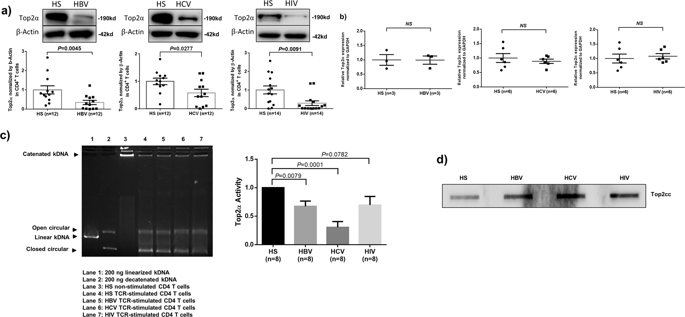Cell Death & Disease ( IF 8.1 ) Pub Date : 2020-03-19 , DOI: 10.1038/s41419-020-2395-2 Xindi Dang 1, 2 , Stella C Ogbu 1, 2 , Juan Zhao 1, 2 , Lam Ngoc Thao Nguyen 1, 2 , Dechao Cao 1, 2 , Lam Nhat Nguyen 1, 2 , Sushant Khanal 1, 2 , Madison Schank 1, 2 , Bal Krishna Chand Thakuri 1, 2 , Xiao Y Wu 1, 2 , Zheng D Morrison 1, 2 , Jinyu Zhang 1, 2 , Zhengke Li 1, 2 , Mohamed El Gazzar 1 , Shunbin Ning 1, 2 , Ling Wang 1, 2 , Zhengqiang Wang 3 , Jonathan P Moorman 1, 2, 4 , Zhi Q Yao 1, 2, 4

|
T cells play a critical role in controlling viral infection; however, the mechanisms regulating their responses remain incompletely understood. Here, we investigated the role of topoisomerase IIA (Top2α, an enzyme that is essential in resolving entangled DNA strands during replication) in telomeric DNA damage and T cell dysfunction during viral infection. We demonstrated that T cells derived from patients with chronic viral (HBV, HCV, and HIV) infection had lower Top2α protein levels and enzymatic activity, along with an accumulation of the Top2α cleavage complex (Top2cc) in genomic DNA. In addition, T cells from virally infected subjects with lower Top2α levels were vulnerable to Top2α inhibitor-induced cell apoptosis, indicating an important role for Top2α in preventing DNA topological disruption and cell death. Using Top2α inhibitor (ICRF193 or Etoposide)-treated primary T cells as a model, we demonstrated that disrupting the DNA topology promoted DNA damage and T cell apoptosis via Top2cc accumulation that is associated with protein-DNA breaks (PDB) at genomic DNA. Disruption of the DNA topology was likely due to diminished expression of tyrosyl-DNA phosphodiesterase 2 (TDP2), which was inhibited in T cells in vitro by Top2α inhibitor and in vivo by chronic viral infection. These results suggest that immune-evasive viruses (HBV, HCV, and HIV) can disrupt T cell DNA topology as a mechanism of dysregulating host immunity and establishing chronic infection. Thus, restoring the DNA topologic machinery may serve as a novel strategy to protect T cells from unwanted DNA damage and to maintain immune competence.
中文翻译:

慢性病毒感染期间拓扑异构酶 IIA (Top2α) 的抑制可诱导端粒 DNA 损伤和 T 细胞功能障碍
T 细胞在控制病毒感染方面发挥着关键作用;然而,调节其反应的机制仍不完全清楚。在这里,我们研究了拓扑异构酶 IIA(Top2α,一种在复制过程中解决缠结 DNA 链所必需的酶)在病毒感染期间端粒 DNA 损伤和 T 细胞功能障碍中的作用。我们证明,来自慢性病毒(HBV、HCV 和 HIV)感染患者的 T 细胞具有较低的 Top2α 蛋白水平和酶活性,并且 Top2α 裂解复合物 (Top2cc) 在基因组 DNA 中积累。此外,Top2α水平较低的病毒感染受试者的T细胞容易受到Top2α抑制剂诱导的细胞凋亡的影响,这表明Top2α在防止DNA拓扑破坏和细胞死亡方面发挥着重要作用。使用 Top2α 抑制剂(ICRF193 或依托泊苷)处理的原代 T 细胞作为模型,我们证明,破坏 DNA 拓扑通过 Top2cc 积累促进 DNA 损伤和 T 细胞凋亡,而 Top2cc 积累与基因组 DNA 上的蛋白质 DNA 断裂 (PDB) 相关。 DNA 拓扑结构的破坏可能是由于酪氨酰 DNA 磷酸二酯酶 2 (TDP2) 的表达减少所致,TDP2 在体外的 T 细胞中受到 Top2α 抑制剂的抑制,在体内则受到慢性病毒感染的抑制。这些结果表明,免疫逃避病毒(HBV、HCV 和 HIV)可以破坏 T 细胞 DNA 拓扑结构,作为宿主免疫失调和建立慢性感染的机制。因此,恢复 DNA 拓扑结构可能作为保护 T 细胞免受不必要的 DNA 损伤并维持免疫能力的新策略。











































 京公网安备 11010802027423号
京公网安备 11010802027423号